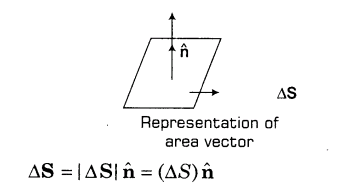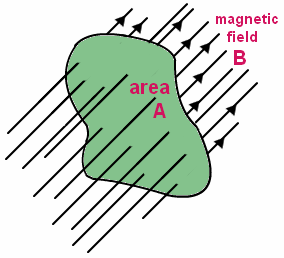I'm trying to find the enclosed current for a non-constant current density equal to $\vec{J}=J_0y^2\hat{x}$. I think I should just be finding $I_{enc}=\int\vec{J}\dot{}d\vec{a}=J_0 y^2\int_{x_0}^{x_f} dx$ right? I'm a little uncertain about if the dot product in the integral.
1 Answer
I think you are confusing what the $d\vec{A}$ stands for in your integral. $d\vec{A}$ is the differential area element. When you are calculating the enclosed current, there is some area that the current passes through. Look at this picture:
In the case above, you have a magnetic field that is going through some area $A$, and so $\int \vec{B} \cdot \, d\vec{A}$ is the magnetic flux through this area. Thus $\int \vec{J} \cdot \, d\vec{A}$ you can think of as the current density flux through an area, and you are integrating over the area.
Another question you might ask is why is $\vec{dA}$ a vector? The differential area element is defined as $$d\vec{A} \equiv A \hat{n},$$ where $\hat{n}$ is the unit vector in the direction that is perpendicular to the area. Check this out below: 
As you can see, the normal unit vector is at a right angle with the area, so the dot product picks out the component that is parallel to this normal direction.
In conclusion, when you are calculating the current enclosed in some area, you must first find $d\vec{A}$, then take the dot product with your current density and integrate over the whole area (surface, which will be a double integral). Hope this helps!
-
$\begingroup$ Okay that makes sense. So if the area is just a square in the x-y plane, then $d\vec{A} = dx dy$? or does it equal $ dx \hat{x} + dy \hat{y}$? $\endgroup$ Commented Nov 30, 2016 at 14:10
-
$\begingroup$ It would be $dxdy\hat{n}$, and then you have to find the normal depending on how it is oriented. For example, if the loop is just in the $x$-$y$ plane, then the normal would stick out of the page so it would be $d\vec{A} = dxdy \hat{k}$. $\endgroup$ Commented Nov 30, 2016 at 15:26
-
$\begingroup$ Ahh, okay. Then the integral is equal to $0$ since it'll be $\hat{x}\dot{}\hat{z}$ right? $\endgroup$ Commented Nov 30, 2016 at 16:00
-
$\begingroup$ Yea if the loop is in the $x$-$y$ plane and the current is in the $x$ direction then the normal and the current are perpendicular, so $0$ flux. $\endgroup$ Commented Nov 30, 2016 at 19:20

